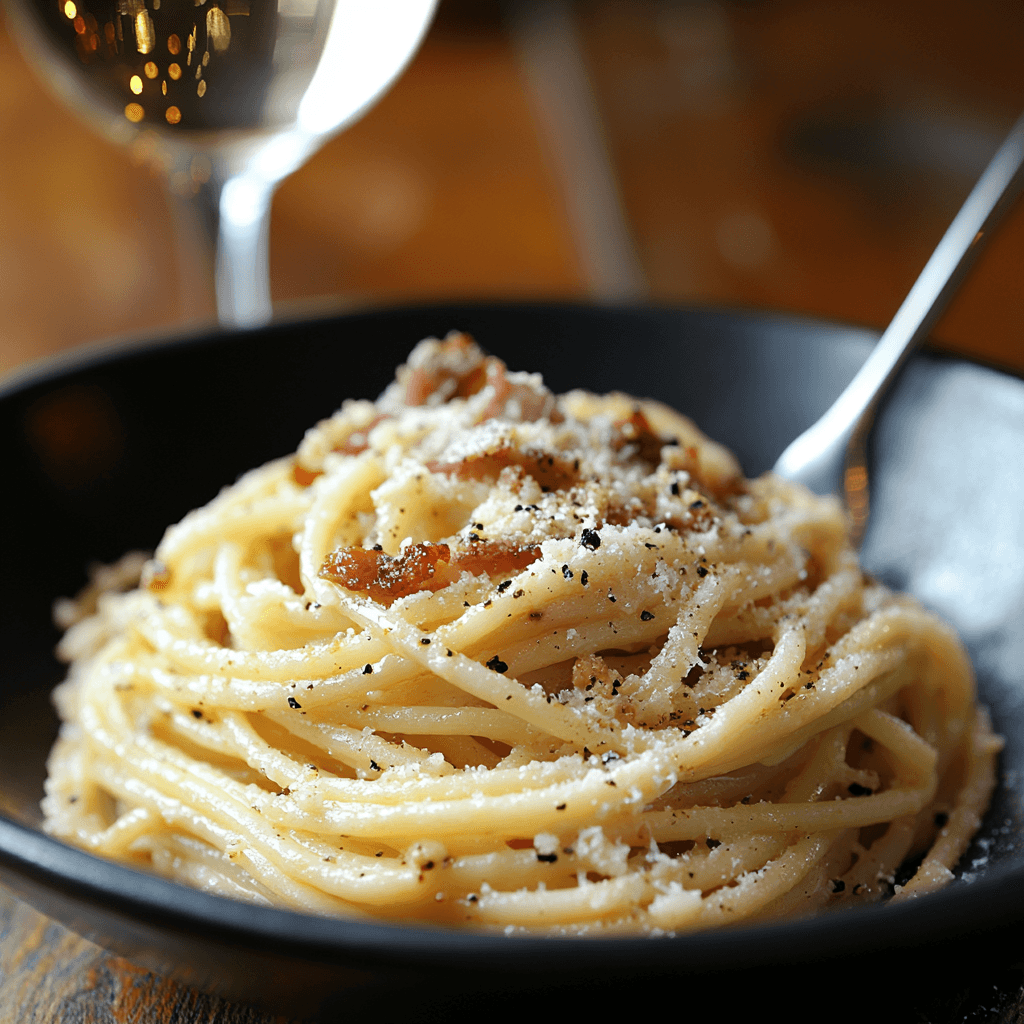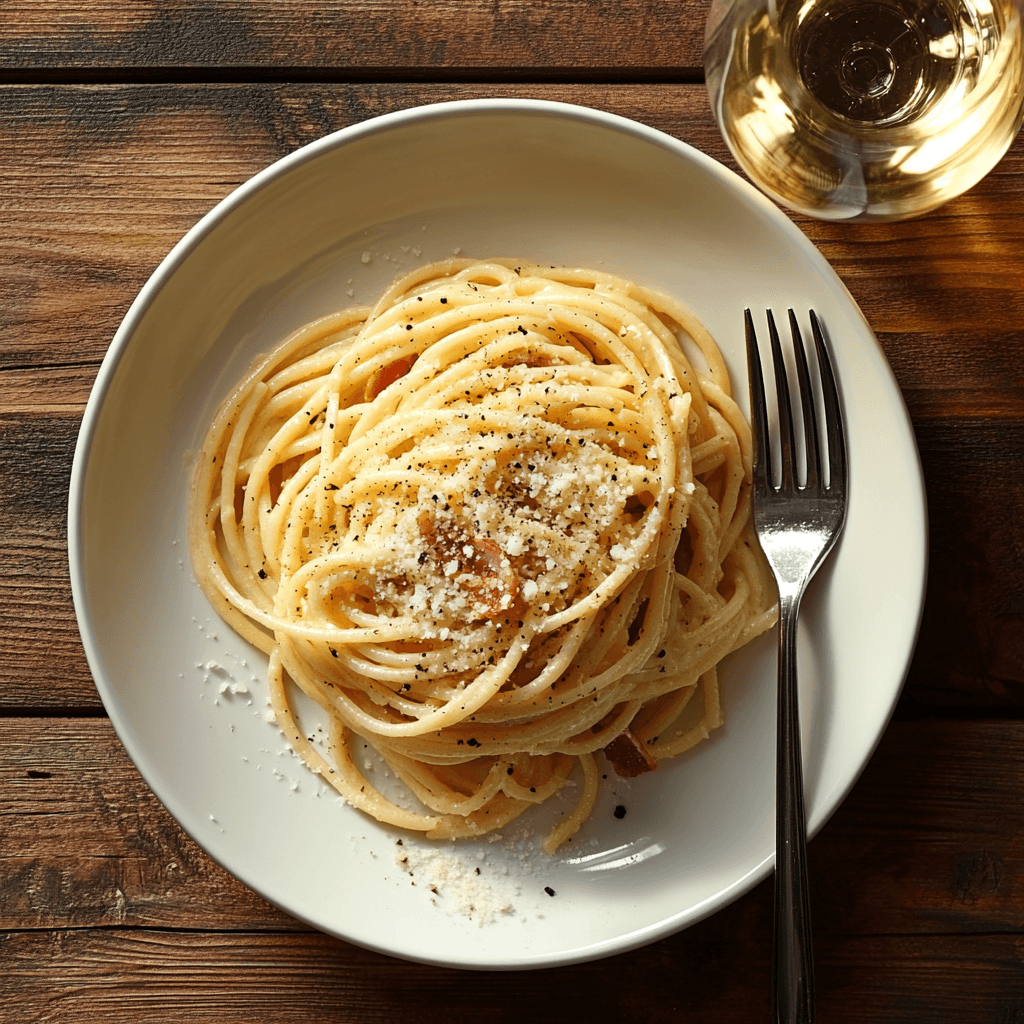Spaghetti Carbonara is a dish that’s simple, delicious, and packed with flavor. But have you ever wondered what makes this pasta so special? Or why some versions taste better than others? Whether you’re a beginner or a kitchen pro, this guide will help you master the art of making perfect Spaghetti Carbonara at home.
“Carbonara is not just a dish; it’s an experience—a symphony of flavors that dance on your taste buds.”
Table of Contents
Introduction to Spaghetti Carbonara
What is Spaghetti Carbonara?
Spaghetti Carbonara is a classic Italian pasta dish that combines simple ingredients—spaghetti, eggs, guanciale (cured pork cheek), Pecorino Romano cheese, and black pepper—to create a creamy, savory sauce without using any cream. The magic happens when the hot pasta and egg mixture blend to create a silky texture that coats every strand of spaghetti. 🇮🇹
A Brief History of Spaghetti Carbonara
The origins of Carbonara are a bit of a mystery. Some say it was created by Italian charcoal workers (carbonai), who made a quick meal using eggs, cheese, and cured pork. Others believe American soldiers during World War II influenced its popularity by introducing bacon and eggs to Italian cuisine. Regardless of its history, one thing is clear: authentic Carbonara follows a strict recipe—and that means no cream!
Why is Spaghetti Carbonara So Popular?
What makes Carbonara a favorite among food lovers worldwide? Simple—it’s:
- Easy to make: With just a handful of ingredients, you can create a restaurant-quality dish in under 30 minutes.
- Incredibly delicious: The combination of crispy guanciale, salty cheese, and creamy egg-based sauce is pure heaven.
- Amazing in texture: Unlike heavy cream-based pasta, Carbonara has a rich yet light consistency.

Spaghetti Carbonara Recipe
Traditional Ingredients of Spaghetti Carbonara :
One of the secrets to making authentic Carbonara is using the right ingredients. Many people make the mistake of using substitutions that alter the flavor. Let’s break down the essential components.
Choosing the Right Pasta: Why Spaghetti?
While some people like to use rigatoni or fettuccine, spaghetti remains the top choice for Carbonara. Why? Because the long, thin strands hold onto the creamy sauce beautifully, ensuring every bite is packed with flavor. If you’re feeling adventurous, try it with bucatini (a hollow spaghetti-like pasta) for an extra twist!
The Importance of Using Guanciale Instead of Bacon
Many recipes swap guanciale for bacon or pancetta, but that’s a mistake. Guanciale is a cured pork cheek with a deep, rich flavor and a higher fat content, which melts into the sauce, giving Carbonara its signature taste. Bacon, on the other hand, is smoked and can overpower the dish. Trust us—guanciale is worth the effort to find!
Eggs, Cheese, and Pepper: The Secret to a Perfect Sauce
Unlike Alfredo or other creamy pastas, Carbonara relies on egg yolks and cheese to create a smooth, velvety sauce. The secret? Mixing them correctly! Here’s the trick:
“Whisk the egg yolks with finely grated Pecorino Romano until it forms a thick paste. This prevents the eggs from scrambling when mixed with hot pasta.”
And don’t forget the pepper! Freshly cracked black pepper (cacio e pepe style) adds a slight kick that balances the dish perfectly.

| Ingredient | Quantity | Notes |
|---|---|---|
| Spaghetti | 400g (14 oz) | Use high-quality durum wheat pasta. |
| Guanciale | 150g (5 oz) | Not bacon! This is traditional cured pork cheek. |
| Pecorino Romano | 100g (3.5 oz) | Aged sheep’s milk cheese; avoid Parmesan if possible. |
| Egg yolks | 4 large | These create the creamy sauce—no cream needed. |
| Black pepper | To taste | Freshly ground for the best flavor. |
| Salt | A pinch | Be careful—Pecorino is already salty! |
How to Make Spaghetti Carbonara: Step-by-Step Recipe
Preparing the Ingredients
Before you start cooking, have everything ready:
- Cut the guanciale into small cubes or strips.
- Grate the Pecorino Romano cheese finely.
- Separate the egg yolks (discarding the whites or saving them for another recipe).
- Boil water for the pasta—don’t add oil! Pasta should be cooked in well-salted water to enhance the flavor.
Cooking the Pasta
Cook the spaghetti until it’s just al dente (firm to the bite). You don’t want it too soft, or it will absorb too much sauce. Save about a cup of pasta water before draining—it’s liquid gold for making the sauce silky!
Frying the Guanciale
While the pasta is cooking, heat a pan over medium heat and cook the guanciale until crispy. It should release its flavorful fat—this will be used to coat the pasta later. No oil needed; guanciale has enough fat on its own!
Making the Egg & Cheese Mixture
Whisk the egg yolks with grated Pecorino Romano and a generous amount of black pepper. It should form a thick, creamy paste. Remember, do not add salt—the cheese and guanciale are already salty enough.
Mixing Everything Together for the Perfect Consistency
Now comes the most critical step—combining the pasta, guanciale, and egg mixture to create that creamy, dreamy Carbonara sauce. Follow these steps carefully:
- Turn off the heat under the pan with the crispy guanciale. You don’t want the eggs to scramble!
- Immediately add the drained spaghetti to the pan with the guanciale. Toss it so that the fat coats every strand.
- Slowly pour in the egg and cheese mixture, stirring quickly and continuously.
- If the sauce is too thick, add a splash of reserved pasta water and keep mixing until smooth.
- Serve immediately with extra Pecorino Romano and freshly ground black pepper. Enjoy!
“The key to perfect Carbonara? Timing! The pasta should be hot enough to cook the eggs into a sauce, but not so hot that they scramble.”
Enhancing Your Carbonara Experience with More Delicious Recipes
If you’re a pasta lover, you’re bound to enjoy other comforting Italian-inspired dishes! While Spaghetti Carbonara is a timeless classic, you might also love trying other rich and cheesy pasta dishes like this Baked Ziti Recipe (No Meat), which delivers a similar creamy, satisfying experience. For those who appreciate hearty and flavorful soups, this Tomato Basil Soup with Grilled Cheese makes an excellent side dish to pair with Carbonara. Additionally, if you’re looking for something on the lighter side, you can explore this 4-Ingredient Potato Soup—a simple yet delicious option that balances out the richness of Carbonara.
Looking for more recipe inspiration? Be sure to check out February Recipes for a curated list of warm and comforting meals to enjoy all month long! Happy cooking!

Common Mistakes When Making Spaghetti Carbonara
Even seasoned cooks make mistakes when preparing Carbonara. Let’s look at the most common errors and how to fix them.
1. Using the Wrong Type of Meat
Bacon and pancetta are common substitutes, but they don’t provide the same depth of flavor as guanciale. If you can’t find guanciale, pancetta is the next best option—but avoid smoked bacon, which changes the dish’s profile.
2. Overcooking or Scrambling the Eggs
This happens when the heat is too high. To prevent this:
- Always remove the pan from heat before adding the egg mixture.
- Mix quickly to allow the residual heat to create a creamy texture.
- Add pasta water gradually to keep the sauce smooth.
3. Adding Cream (Don’t Do It!)
Traditional Carbonara gets its creaminess from eggs and cheese—not heavy cream! Adding cream makes it richer but takes away from the authentic taste. Stick to the classic method for the best results.
4. Not Mixing the Pasta and Sauce Correctly
If your Carbonara is clumpy or dry, you probably didn’t mix it fast enough or didn’t use enough pasta water. Keep stirring and adding water until the sauce evenly coats the pasta.
How to Fix Spaghetti Carbonara Mistakes
Messed up your Carbonara? Don’t worry! Here’s how to fix common issues:
🥄 How to Fix a Sauce That is Too Thick or Too Thin
| Problem | Solution |
|---|---|
| Too thick | Add a small amount of pasta water and mix quickly to loosen it. |
| Too thin | Add more cheese and stir over low heat for a few seconds. |
How to Avoid Scrambled Eggs in Carbonara
If your Carbonara turned into an eggy mess, it means the heat was too high. Next time:
- Remove the pan from heat before adding the egg mixture.
- Stir quickly and continuously.
- Add more pasta water if needed to balance the texture.
What to Do If Your Carbonara Lacks Flavor
If it tastes bland, the likely culprit is:
- Not enough Pecorino Romano—add more!
- Guanciale wasn’t crispy enough—make sure to cook it properly.
- Not enough black pepper—Carbonara needs a good amount for depth.
Variations of Spaghetti Carbonara
While purists insist on the classic recipe, there are plenty of fun twists you can try. Here are some popular variations:
1. Modern Twists on the Classic Recipe
- Truffle Carbonara: Add a drizzle of truffle oil or fresh truffle shavings for an elegant touch.
- Mushroom Carbonara: Sautéed mushrooms add extra umami and depth.
- Spicy Carbonara: Add red pepper flakes or Calabrian chili for some heat.
2. Vegetarian and Vegan Carbonara Alternatives
Want a meat-free version? Try these swaps:
- Replace guanciale with sautéed mushrooms or smoked tofu.
- Use nutritional yeast instead of Pecorino Romano.
- Swap eggs for a creamy cashew-based sauce.
3. Regional Differences in Carbonara Recipes
Different parts of the world put their own spin on Carbonara:
- Rome: The traditional way—guanciale, Pecorino, eggs, and pepper.
- France: Often adds cream (controversial!).
- America: Frequently uses bacon and Parmesan.

Pairing Spaghetti Carbonara with Drinks and Side Dishes
Carbonara is rich and salty, so pairing it with the right drink or side dish enhances the experience. Here’s what works best:
The Best Wines to Pair with Spaghetti Carbonara
- White Wine: Pinot Grigio or Sauvignon Blanc—crisp and refreshing.
- Red Wine: Chianti or Barbera—light but flavorful.
- Sparkling Wine: Prosecco—cuts through the richness.
Side Dishes That Complement Carbonara Perfectly
- Garlic Bread: Adds crunch and a bit of extra flavor.
- Simple Green Salad: Lightens up the meal.
- Roasted Vegetables: A great way to balance the richness.
FAQs About Spaghetti Carbonara
1. Can I Use Parmesan Instead of Pecorino?
Yes, but Pecorino Romano is preferred because it has a sharper, saltier flavor that complements Carbonara better.
2. Is It Okay to Add Garlic to Carbonara?
Traditional Carbonara does not include garlic, but some modern versions add it for extra aroma.
3. How Do I Make Carbonara for a Large Group?
Cook in batches! Mixing large amounts of pasta and sauce at once can be tricky, so work in smaller portions.
Final Thoughts: Enjoying the Perfect Plate of Carbonara
Spaghetti Carbonara is more than just a meal—it’s a timeless classic that celebrates the beauty of simple ingredients. Whether you’re making it for the first time or refining your technique, remember:
“The best Carbonara is made with patience, love, and respect for tradition.”
Now, grab your ingredients and start cooking!
